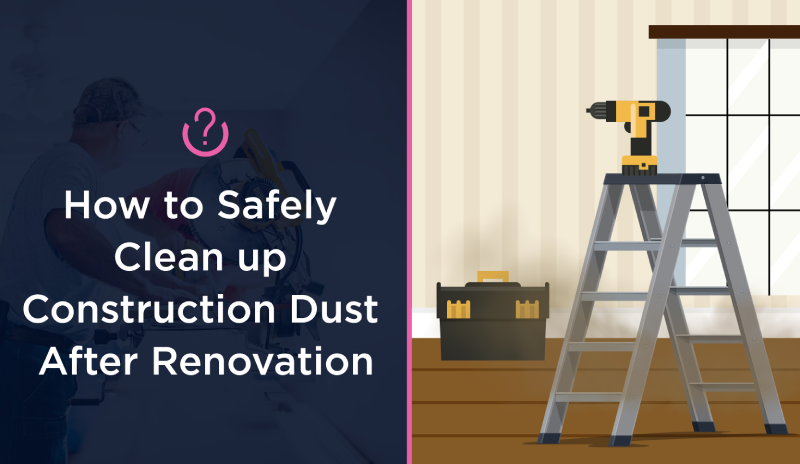
So, you just completed a much needed but exhausting renovation project. Now what? Well, renovation cleanup is usually the last step of your home improvement projects. Whether you've tackled the renovation yourself or you've been working with professional contractors in your home, construction dust cleanup starts the second all the tools are put away. Even if the contractors you’ve worked with have already done some amount of tidying up, a thorough cleanup is still necessary to ensure a clean, safe environment.
We'll look at some best dust-removal tools that should be part of your cleanup arsenal and why post-construction cleanup should be a top priority to reduce the risk of airborne irritants.
Construction Dust Health Risks
If during your renovation project there has been sanding or sawing of wood, tile, or drywall, prolonged exposure to construction dust that’s not thoroughly removed can have a serious impact on your health. Consistent exposure to these irritants can cause respiratory problems and trigger allergy symptoms.
Whether you're using one or multiple home service contractors, talk to each one about what you can expect when it comes to the actual work and cleanup. A reputable contractor will be more than happy to explain the job and how they intend to do a thorough cleanup (including construction dust) after any project is complete.
Home Renovation Dust Cleanup Tips
The same risks associated with long-term exposure to construction dust are also present when tackling the initial cleanup. If you have current or past respiratory health concerns or are sensitive to dust, consider hiring professionals to help remove construction dust from your living spaces.
Post-construction cleanup requires protective gear to guard your eyes and lungs from the particle pollution. We strongly recommend wearing personal protective equipment (PPE), including:
- Protective goggles that cover your eyes
- A professional-grade N95 mask
- Work gloves or rubber gloves if there's a chance you may encounter liquid chemicals
Post-Renovation Cleanup Tools
Having the right tools on hand can significantly simplify the cleanup process after a renovation. Depending on the size and scope of the project, you might consider renting equipment for a more efficient and thorough cleanup. To get started, consider the following essentials:
- Wet-Dry Vacuum: Perfect for handling both large debris and fine dust without redistributing particles into the air.
- Microfiber Cloths: Effective for trapping and removing fine dust from surfaces without leaving residue.
- Extendable Dusters: Great for reaching high ceilings, light fixtures, and other elevated areas.
- High-Quality Brooms: Useful for sweeping larger areas and gathering debris efficiently.
- Plastic Sheeting: Helps to cover furniture, vents, and doorways to prevent dust from spreading.
- Steam Mop or Scrubber: Ideal for deep cleaning floors, especially tiles or hardwood, to remove lingering dust and dirt.
Equipped with these tools, you’ll be able to tackle post-renovation cleaning quickly and ensure your space is fresh, safe, and ready to enjoy.
Related Topic: Cleaning Supply Checklist
Cleanup Renovation Dust Safely
Give yourself plenty of time to complete the list of steps below and consider bringing in a few helping hands.
Prepare for Post-Renovation Cleaning
Post-renovation cleaning can be a time-consuming process, so it’s essential to plan ahead. Give yourself ample time to complete the steps outlined below, as rushing through this cleanup could leave behind lingering dust and debris. To tackle this task effectively, gather the following tools and supplies:
- A Broom or Long-Handled Duster: Perfect for reaching elevated areas like ceilings, corners, and trim where dust tends to settle.
- A Wet-Dry Vacuum: This versatile tool can handle everything from fine construction dust to larger debris, making it a must-have for thorough cleaning.
- Microfiber Cloths: Ideal for trapping smaller dust particles on surfaces like furniture, windowsills, and shelving.
- Plastic Sheeting: Useful for covering doorways, vents, and furniture to prevent dust from spreading or settling on clean surfaces.
Once you’ve assembled these essentials, you’re ready to dive into the cleaning process. Taking the time to prepare properly will make the task more manageable and help ensure your newly renovated space is clean, safe, and ready to enjoy.
How to Get Started with Construction Dust Cleanup
Getting started with construction dust cleanup requires careful planning to ensure your space is restored to a safe and clean environment. Follow these steps to begin:
- Seal Off Unaffected Areas: Protect parts of your home that weren’t involved in the renovation by sealing off doorways with plastic sheeting. This prevents dust from spreading to other areas. Cover nearby furniture with plastic or bedsheets to shield it from airborne particles. Additionally, briefly cover HVAC vents to stop dust from circulating through your home’s air system.
- Start with Elevated Surfaces: Use a broom or long-handled duster to clean elevated areas like ceilings, windowsills, and door trim. Work systematically from high points down to lower surfaces, ensuring dust falls to areas you can vacuum later. For surfaces within arm’s reach, a microfiber cloth is ideal for capturing fine dust particles. Allow about an hour for airborne dust to settle after cleaning high spots before moving to floors or lower areas.
- Focus on the Floors: After dusting, use a wet-dry vacuum to tackle the dust and debris on the floor. This tool is effective for collecting fine dust as well as larger particles like splinters or bits of drywall. Be prepared to make multiple passes over heavily affected areas to ensure all debris is removed.
By following these steps, you’ll create a clean and safe space while protecting your newly renovated home from lingering construction dust.
Second Round Cleanup: Removing Settled Construction Dust
A week later, you may need to do a second cleanup as more airborne construction dust has had time to settle. For this cleaning, you'll rely on some of the same cleaning equipment noted above, as well as a trusty mop.
- While it may not be necessary, consider wearing the same personal protective equipment to avoid contact with lingering construction dust.
- Dust the area as you normally would. You shouldn’t need to cover adjacent doors or vents with plastic at this point. Read our tips for dusting efficiently.
- Use a microfiber cloth to capture the finer dust on more hard-to-reach places like bookshelves.
- Use a mop with water to tackle the affected floors. Be sure to use the appropriate cleaner for your flooring material.
Now that your home renovation is truly finished, congratulations!
When to Seek Professional Help for Construction Dust Removal
Sometimes, post-renovation cleanup can feel overwhelming, especially after large-scale projects or if construction dust has spread extensively throughout your home. If you have respiratory health concerns, limited time, or lack access to proper cleaning equipment, hiring professional cleaners is a smart option.
Professionals have the tools and expertise to thoroughly remove construction dust, including hard-to-reach areas and stubborn debris. They can save you time and ensure your home is left spotless and safe for you and your family. If cleanup feels too challenging to handle on your own, don’t hesitate to seek help from a trusted cleaning service.
Get Professional Cleaning Help For Your Post Construction Cleanup
A renovation project can really revitalize your home space by creating a fresh, new look and feel. But you’ll enjoy your new and improved home more if it’s kept nice and clean. Molly Maid offers custom cleaning schedules and services that can help keep your home tidy and clean, including dusting to help remove any construction particles that might be lingering after your cleanup. To learn more or get started, give us a call or request an estimate today!
